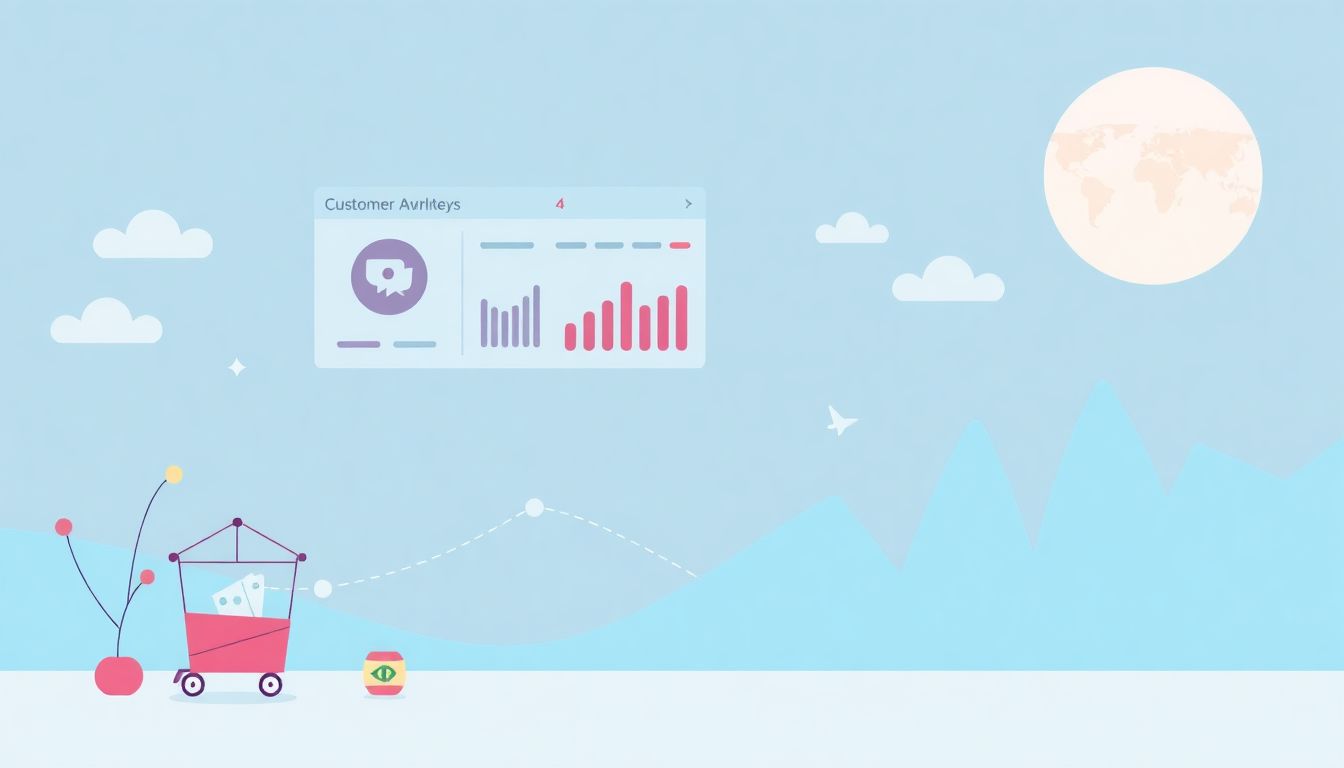Mapping the customer journey can feel like piecing together a complex puzzle. With so many touchpoints and interactions, it’s easy to get lost in the details or miss the bigger picture. You’re not alone in feeling overwhelmed; many businesses struggle to understand their customers’ experiences fully.
But what if I told you there’s a way to simplify this process? Stick around, and you’ll discover how ChatGPT can transform your customer journey mapping into a smoother, more engaging experience. You’ll learn how to harness AI to uncover insights and create maps that really resonate with your audience.
From practical steps on using ChatGPT to real-world success stories, we’ve got all the tips you’ll need to elevate your customer journey mapping game. Let’s jump in!
Key Takeaways
- Customer journey mapping helps visualize all touchpoints where customers interact with your brand.
- ChatGPT simplifies mapping by providing data-driven insights and automating customer dialogues.
- To utilize ChatGPT, define your objectives, gather data, and simulate customer interactions.
- Effective use of prompts can yield valuable insights about customer behaviors and feelings.
- Integrating ChatGPT improves personalization, streamlines processes, and boosts customer satisfaction.
- Be aware of AI biases and ensure data privacy to build trust with customers.
- Continuous iteration and team collaboration enhance the accuracy and relevance of your journey maps.

Enhancing Customer Journey Mapping with ChatGPT
Customer journey mapping is crucial for businesses aiming to improve customer experience and optimize their interactions.
By utilizing ChatGPT, companies can enhance their customer journey mapping processes, making them more efficient and insightful.
This AI tool assists in identifying customer touchpoints, understanding behaviors, and analyzing pain points throughout the customer lifecycle.
Leveraging AI in this way allows businesses to create personalized experiences that resonate with their customers.
Understanding Customer Journey Mapping
Customer journey mapping is the process of visualizing the steps a customer takes when interacting with a business.
The goal is to illustrate every touchpoint where a customer interacts with your brand, from initial awareness to post-purchase support.
It’s essential to segment journeys based on various stages, such as awareness, consideration, decision, and retention.
Each customer’s emotions and behaviors are crucial to understanding their experience, helping you identify pain points and opportunities for improvement.
By analyzing these elements, businesses can optimize their interaction pathways and enhance overall customer experience (CX).
How ChatGPT Can Assist in Mapping Customer Journeys
ChatGPT serves as a powerful assistant in mapping customer journeys by providing automated insights and real-time feedback on customer interactions.
This AI can analyze vast amounts of data to identify patterns in customer behavior and preferences.
By integrating ChatGPT into your workflow, you can simulate customer interactions and gather detailed insights without manual intervention.
Moreover, it enhances empathy in customer interactions, allowing businesses to understand and cater to customer needs effectively.
The AI’s conversational capabilities enable it to facilitate real-time discussions that can pinpoint gaps in customer journeys.
Steps to Use ChatGPT for Customer Journey Mapping
Implementing ChatGPT into your customer journey mapping begins with a systematic approach.
- Define Your Objectives: Clearly outline what you want to achieve through customer journey mapping.
- Gather Data: Compile existing customer data and insights that will inform the mapping process.
- Initiate Conversations: Use ChatGPT to simulate customer dialogues and explore potential journey scenarios.
- Analyze Outputs: Assess the AI’s findings to identify trends and pain points within the customer journey.
- Iterate Mapping: Continuously refine your customer journey map based on feedback and insights generated by ChatGPT.
- Implement Changes: Use the refined map to improve customer interactions and touchpoints across the board.
By following these steps, you can effectively integrate ChatGPT into your customer journey mapping practices, leading to enhanced efficiency and customer satisfaction.

Examples of Customer Journey Prompts for ChatGPT
Using prompts effectively can unlock a treasure trove of insights from ChatGPT.
Here are several ready-to-use prompts that will help you simulate customer journeys and understand their perspectives better.
- “Create a customer journey map for a first-time buyer of eco-friendly products in an online store.”
- “List the common touchpoints a customer experiences during the awareness stage of a new software product.”
- “What emotions might a customer feel while navigating through our website from product search to checkout?”
- “Draft a series of possible customer questions during the consideration phase of a travel service booking.”
- “Analyze the potential reasons why a customer might abandon their cart after adding products.”
- “Suggest improvements for our email follow-up strategy after a purchase is made.”
- “Identify key pain points a customer might face in the post-purchase experience in a subscription service.”
- “Generate a list of customer feedback questions for our latest product launch.”
Feel free to adapt these prompts based on your specific industry or customer needs.
Using these snippets directly will help you engage with ChatGPT to refine your understanding of customer journeys.
Benefits of Using ChatGPT in Customer Journey Mapping
Integrating ChatGPT into your customer journey mapping comes with a host of benefits.
First, it enables improved customer understanding by analyzing interactions at scale.
This means you can gather insights into customer preferences and behaviors more efficiently.
Second, ChatGPT enhances personalization efforts.
By tailoring interactions based on AI analysis, businesses can create more engaging experiences.
Additionally, this tool streamlines the journey mapping process, saving time and resources.
ChatGPT also helps reduce response times in customer service, leading to higher satisfaction rates.
It’s safe to say that employing AI will maximize engagement and improve your overall business performance.
Common Challenges and Solutions When Using ChatGPT
While ChatGPT offers enormous potential, it’s not without challenges.
One common issue is bias in AI outputs, which can skew customer insights.
To mitigate this, ensure diverse data inputs and regularly review AI recommendations for context.
Another hurdle is the AI’s occasional inaccuracies in understanding customer intent.
You can improve accuracy by refining your prompts and providing ChatGPT with context.
Data privacy is another concern; ensure you are compliant with relevant regulations.
Establish transparent data practices to build customer trust as you implement AI solutions.
By proactively addressing these challenges, you can maximize the benefits while minimizing risks.
Best Practices for Effective Customer Journey Mapping with ChatGPT
To harness the full power of ChatGPT for customer journey mapping, consider these best practices.
First, maintain a focus on iterative mapping.
This involves continuously refining your customer maps based on new insights and feedback.
Second, utilize feedback loops to involve various teams in the mapping process.
Collaboration leads to a more comprehensive understanding of customer experiences.
Ensure data validation at each step to confirm the accuracy of insights generated.
Additionally, adapt your mapping strategies to shifts in customer behavior and market trends.
Regularly updating your approach guarantees that your journey maps stay relevant and effective.
By following these practices, you’ll enhance your customer journey mapping efforts and drive better outcomes for your business.

Case Studies: Success Stories of ChatGPT in Customer Journey Mapping
Real-world examples can illustrate how ChatGPT effectively transforms customer journey mapping.
One notable success story comes from a leading e-commerce platform that integrated ChatGPT to analyze customer feedback.
By mapping customer sentiments, they identified key pain points across the purchasing process.
As a result, they enhanced their user interface, which led to a 20% increase in conversions.
Another example involves a travel company that employed ChatGPT to enhance their customer engagement strategies.
Utilizing prompts to understand customer inquiries helped them fine-tune their travel packages based on real needs.
This change resulted in a 15% increase in repeat customers, proving the effectiveness of tailored journeys.
These case studies highlight practical applications of ChatGPT that can yield measurable results in customer experience enhancement.
Conclusion: The Future of Customer Journey Mapping with AI
The future of customer journey mapping is undeniably intertwined with advancements in AI technologies like ChatGPT.
As businesses adopt AI-driven solutions, they can anticipate customer needs more accurately and create personalized experiences.
Emerging trends show a growing emphasis on data analytics, which empowers brands to understand their customers better.
This informed approach leads to sustainable practices and long-term customer loyalty.
Additionally, as AI continues to evolve, it will provide even richer insights, enabling faster adaptations to changing market dynamics.
Ultimately, the integration of AI into customer journey mapping will prove essential for businesses looking to thrive in a highly competitive landscape.
Embracing these innovations will not just improve customer interactions; it will shape the next generation of customer experiences.
FAQs
Customer journey mapping is a visual representation of the steps customers take when interacting with a business. It highlights touchpoints, emotions, and pain points to improve customer experience and engagement.
ChatGPT can assist by generating personalized customer journey insights, suggesting improvements, and providing real-time feedback based on customer interactions, thereby enriching the mapping process with data-driven recommendations.
Benefits include increased efficiency in identifying customer pain points, enhanced customization of customer experiences, and the ability to simulate various scenarios, leading to more informed decision-making.
Common challenges include data accuracy, the need for prompt engineering, and ensuring context relevance. Solutions involve refining prompts, implementing continuous feedback loops, and training ChatGPT with specific customer data.
